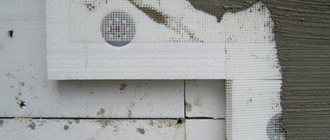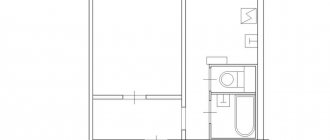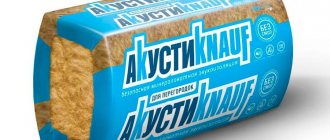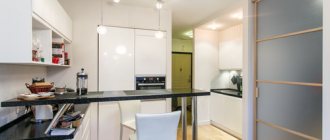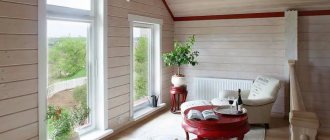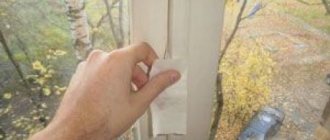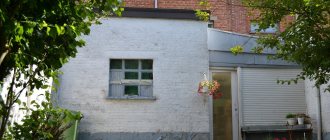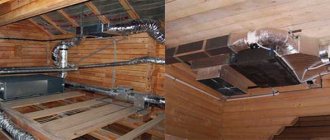Increasing the effectiveness of a noise barrier is a common task in urban housing. Not only sounds from neighbors, but also vibrations during impact repair work can pass into rooms that are not sufficiently isolated by capital partitions. All this causes significant discomfort to residents, forcing them to look for additional means of noise reduction. And the basic design solution in this direction will be effective sound insulation of walls. In an apartment, this problem can be solved in different ways without radically invading the structure of the walls and reducing the usable area in the premises.
Sound insulation standards in panel houses
In Russia, noise insulation standards are strictly regulated and enshrined in the code of rules for noise protection SP 51.13330.2011. The standards concern airborne and impact noise levels:
- airborne noise (voices, music, etc.) - sound insulation at 50 dB;
- impact noise (repair work, moving furniture) - the permissible sound pressure level is 60 dB.
According to building codes, the optimal thickness of a reinforced concrete floor is considered to be 160 mm. For inter-apartment partitions, 100-150 mm is sufficient. But practice shows that a comfortable stay in an apartment in terms of noise level will be possible with a partition thickness of more than 200 mm.
Important! The authors of modern studies on noise claim that the necessary acoustic comfort is achieved only with a noise insulation index above 62 dB.
Wall sound insulation kit from Knauf
Especially for home use, it offers combined supersheet panels based on wood cellulose and gypsum. This is a facing material that can be used as a preparatory solution for decorative finishing. Such sheets not only provide a soundproofing barrier, but also level the surface, not to mention the insulation effect. At a basic level, it is recommended to use a single layer of soundproofing of walls in an apartment from neighbors. Reviews indicate that the double layer significantly increases protection against airborne noise. According to the calculations of the developers of this insulator themselves, the effect increases by 9 dB. If necessary, you can use a multilayer installation configuration of supersheets, which will also increase the reliability of future installation of decorative finishes.
The positive qualities of Knauf panels are determined by a special technology of weaving fibers, the arrangement of which ensures that the base absorbs some of the noise. Users also note the convenient standard size of the slabs with a width of 610 mm. Thanks to this format, it becomes possible to rationally place segments along the walls of the room with minimal formation of “noise bridges”.
Reasons for poor sound insulation of panel houses
There are several reasons why panel houses cannot boast of good insulation from airborne and impact noise:
- low quality of construction and repair work, the presence of unsealed seams and gaps between the slabs;
- poor housing design, which leads to poor joining of panels, cracks and distortions;
- non-compliance with the technology for installing inter-apartment and interior partitions;
- the use of cheap and low-quality soundproofing materials;
- non-compliance with standards for the thickness of floors and partitions;
- illegal redevelopment of an apartment by neighbors in violation of building codes;
- violations during the installation of window frames and doorways, as a result of which their tightness is reduced.
The main reason for poor sound insulation is the desire of developers to save money on building construction, primarily on sound insulation. It is impossible to assess its quality without special equipment and the involvement of specialists, and the percentage of savings for the developer on soundproofing materials will be up to 40%.
Basalt sound insulation from TechnoNIKOL
In the line of sound insulators of this brand, one can highlight the “Technoacoustic” material. This is a whole group of fire-resistant and water-repellent coatings made from mineral rocks of basalt structure. Again, the non-standard method of fiber formation gives the material high noise-reducing qualities, and the structural form factor provides ample opportunities for installing finishing cladding. What is also noteworthy is that in reviews of the soundproofing of walls in an apartment from TechnoNIKOL neighbors, users of the material indicate the possibility of combining it with partitions. We are talking about frame-sheathing structures into which it is convenient to integrate basalt panels. Unlike thin sheets, they are characterized by high density and rigidity, so you do not have to worry about the destruction of the structure under stress forces inside the frame.
Soundproofing materials
The owners of an apartment with poor sound insulation are most often forced to solve the problem themselves. First, you will have to figure out the sources of extraneous sounds, and then start purchasing soundproofing materials.
Important! It is impossible to achieve 100% sound insulation in a building; it will be enough to reduce the noise level to an acceptable level.
Modern building materials make it possible to achieve high-quality sound insulation both in a new building and in a long-constructed building.
Soft insulation
Soft roll materials have good sound-absorbing characteristics and are small in thickness. They do not take up space and can be used even in small apartments. Soft insulation is capable of not only absorbing third-party noise, but also repelling it from its surface, and thanks to its porous and elastic structure, sound vibrations are distributed evenly over the entire thickness of the building material.
Basalt (mineral) wool
Mineral wool is made from gabbro-basalt rocks with the addition of binding materials. Urea resins, bentonite clays, phenolic alcohols, bitumen and composite compositions can be used as binders.
Important! During the installation process, insulating wool is placed between the profiles or fixed to the surface using cement-based adhesive.
The material is produced in the form of rolls or slabs and is used for finishing walls, ceilings and decorative partitions.
Cork
Rolled material with a natural composition and a polyurethane binder. The structure of the material resembles many frozen bubbles that retain heat inside and do not allow noise to penetrate inside.
Cork is an excellent solution for new buildings where the use of special soundproofing compounds is not provided. The cork surface is well held on the floors with the help of an adhesive composition.
Penolon
The material is made from polymers that are foamed using a certain technology and saturated with hydrocarbons. The result is a three-dimensional product with a cellular structure and excellent soundproofing characteristics. The material retains heat well, repels moisture and absorbs noise.
Penolon is used to insulate all parts of a building - when laying the foundation, arranging the roof, for insulating door and window structures, and as a backing for laminate flooring.
Cork rubber backing
Composite material, which is a mixture of granulated cork and synthetic rubber. It is used as a layer under floor coverings, ceramic tiles, natural stone slabs, etc.
The material reduces impact noise well and dampens vibration of electrical appliances.
Solid insulation
Solid materials have increased sound insulation characteristics. But due to the large thickness of the insulating layer, they can reduce the physical volume of space, which makes them unsuitable for furnishing small apartments.
Styrofoam
White foamed plastic gas-filled mass is one of the most popular materials for insulation and sound insulation of walls and ceilings. Foam boards are safe for human health, have a long service life, and are resistant to burning and rotting. Polystyrene foam easily glues to other materials, is easily cut with a knife or handsaw, and is attached using special glue or dowels with wide heads.
Expanded polystyrene
It is produced by adding gas to the polymer mass of polystyrene. In terms of performance characteristics, it exceeds polystyrene foam - it is stronger and better protects against noise.
Important! Expanded polystyrene is highly flammable, so when purchasing, you should pay attention to fire-resistant varieties of this material.
Multilayer panel
The design consists of sandwich panels and finishing plasterboard facing sheets, 12.5 mm thick. The material does not require a metal frame - fastening to the wall is done using special units provided by the product design.
Sound insulation is also achieved through the use of the following materials:
- basalt fiber slabs;
- glass wool;
- polyester fiber boards;
- fiberglass boards;
- drywall;
- mineral membranes based on aragonite;
- bitumen-cork substrate;
- fiberglass;
- vibroacoustic sealant;
- silica fiber;
- sound-absorbing wallpaper.
Handy sound insulation
The easiest way to reduce noise in a room is to use interior items:
- thick curtains on the windows;
- carpets on the walls;
- carpeting on the floor;
- furniture walls and slides;
- soft headboards on the walls.
Important! Using improvised methods, it is possible to achieve a reduction in noise levels by 20-30%.
Frame and frameless panels
The method of implementing the panel design is fundamentally important in the context of choosing a sound insulator. The market offers panels with a frame and frameless base, and this division is quite arbitrary. The form factor of the material itself remains the same, but the principle of its installation and a number of performance qualities change. To understand these differences, it is necessary to determine the characteristics of each group separately.
Frame panels require permanent installation on a wall surface using auxiliary devices in the form of frames, profiles, sheathing, brackets with corners, etc. That is, an installation base is initially formed, and then installation is carried out on it. This type of soundproofing of walls in an apartment protects against impact and structural noise, eliminating the transmission of vibration vibrations through the structure. The thickness of such insulation varies from 5 to 10 cm.
Frameless panels are oriented towards forming a barrier against airborne noise, the source of which can be conversations, musical equipment, a loud TV, barking dogs, etc. The installation of such an insulator does not involve the formation of a special supporting base, so the material is literally applied and fixed to the surface using glue or hardware. The advantage of this solution is also its insignificant impact on the thickness of the walls - the build-up rarely exceeds 4-5 cm.
Do-it-yourself soundproofing of an apartment in a panel house
To achieve maximum protection from noise in an apartment, experts recommend not limiting yourself to just insulating the ceiling and floor. Insulation installation requires the entire perimeter of the room, as well as sockets, mounting boxes, risers, air ducts, window frames and doorways. This is the only way to achieve maximum protection from sounds of any origin and direction.
Materials and tools
Depending on the type of soundproofing material chosen, the set of tools for the work will differ.
What you may need:
- construction cord and plumb lines;
- tape measure and pencil;
- adhesive composition in accordance with the type of sound insulator;
- perforator;
- dowels with wide caps;
- screwdriver;
- metal profiles;
- putty knife;
- construction knife;
- metal scissors;
- putty or cement mortar;
- self-tapping screws;
- reinforcing and soundproofing tapes;
- glue gun;
- masking tape;
- personal protective equipment (mask, goggles, gloves).
Important! Soundproofing a room starts with the walls, then finishes the ceiling and ends with soundproofing the floor.
Soundguard panels
An innovative solution to the problem of sound insulation in the form of a combined coating with quartz filling. The rigid structure is formed by layers of cardboard profiles, and between them are quartz granules that have undergone heat treatment. As a result, the panel thickness is about 12 mm, which significantly increases the effectiveness of the sound barrier. In practice, wall soundproofing panels for interior wall decoration of the Soundguard system provide a reduction in impact noise energy, preventing the spread of air waves across the entire frequency spectrum.
However, when choosing such panels, you should also prepare for a thorough installation with a supporting structure, which is required due to the large mass of the coating. It is advisable to mount the frame taking into account the optimal configuration for placing the segments. By the way, the panels can be easily sawed with minimal risk of chipping. Reviews about the soundproofing of walls in an apartment from Soundguard neighbors note that high-quality cutting is possible with an ordinary hacksaw, but for a better result it is better to use electric saws or a jigsaw. Subsequently, the edges are carefully covered with proprietary Soundguard Tape.
Soundproofing walls in an apartment
Work on soundproofing walls begins with identifying cracks and holes. All detected defects must be covered with putty, and large holes must be plastered.
The optimal way to soundproof walls is to install a plasterboard structure, inside which one of the types of rolled or rigid insulating materials is placed.
Step-by-step instruction:
- Make marks on the surface of the floor and ceiling, connect them with construction cord.
- Attach the guide profile to the floor, ceiling and wall using a hammer drill and dowels.
- Cover the bottom of the profile with soundproofing tape.
- Install the corners of the rack profile into the guide profile and secure the products with screws.
- Place sheets of the selected sound insulator into the resulting frame.
- Attach drywall to the top using self-tapping screws.
- Apply reinforcing tape to the joints between the plasterboard sheets, and additionally fill the holes on top.
Important! When installing soundproofing filler, it is necessary to lay its sheets as closely as possible to each other, otherwise the entire sound absorption effect will come to naught.
Plates from ROCKWOOL
Also a specialized solution for organizing a sound barrier in the form of sheets intended for laying on wall surfaces. The geometry and surface structure of this material allows it to be used as a lining for sensitive decorative coatings. For example, this is optimal sound insulation for walls in an apartment under wallpaper, which can even out the smallest errors in the base.
If we talk about soundproofing qualities, the ROCKWOOL product focuses on protection against airborne noise. At the household level, this method eliminates the penetration of the sounds of children crying, loud music and dog barking. The material is based on stone (mineral) wool, the particles of which are held together with a binder. According to reviews of the soundproofing of walls in an apartment from neighbors of this brand, the greatest effect can be achieved by using the frame installation method. The company offers a complete set of such a solution with sealing tape, fastening profiles and guide components. The use of several layers on a rigid sheathing allows you to achieve a sound insulation effect of 30 dB.
Soundproofing the ceiling in an apartment
For the ceiling, it is better to choose lightweight materials that will not peel off from the surface under their own weight. Special membrane products, sound-absorbing boards, and ZIPS panels will cope well with the function of protecting the ceiling.
Soundproofing the ceiling can be done using the same method as soundproofing the walls. Drywall and a layer of insulating material will do an excellent job of protecting against extraneous noise and cold. However, this technology is more suitable at the stage of rough or major repairs, when it is possible to carry out large-scale finishing work.
If the need for sound insulation arose later, it is better to abandon the construction of the frame in favor of soundproofing panels.
Stages of work:
- Preliminary preparation of the ceiling - remove the old decorative coating, cover up the cracks.
- Apply insulating strips along the perimeter of the ceiling.
- Starting from the corner of the room, mark the ceiling - outline the contours of the slabs and places for fastening screws.
- Place the panel according to the markings made and drill holes for the screws.
- Attach the slab to the ceiling using the vibration-isolating fasteners that come with it.
- Cover the entire ceiling, carefully adjusting the panels to each other.
Important! Either a suspended or stretch ceiling is installed on top of the soundproofing material.
Features of decorative insulation panels
It has already been noted that soundproofing panels can also be used as a base for the subsequent installation of the finishing coating. Modern technologies make it possible to organically combine the functions of a sound insulator with a decorative effect. The base of the material in this case is made with noise reduction in mind, and the outer part is a decorative coating. In this way, it is possible to replace traditional cladding made of wallpaper, MDF, plasterboard, etc. The base usually uses the same pine-needled wood-shaving layers, and the outer side is a fabric finish or a layer of vinyl wallpaper, which can be washed and even repainted in the most favorable color. In addition, soundproof decorative panels for apartment walls are installed with minimal seams thanks to the tongue-and-groove system. Assembly and installation do not require special skills, and for fastening delicate methods of connection to the surface are used, such as “liquid nails” or thin hardware elements.
Soundproofing the floor
In a panel house with a concrete floor, it is better to use floating soundproofing screed technology:
- Clean the floor from debris and dust, seal any cracks and defects found.
- Place a layer of the selected soundproofing material on the clean floor.
- Lay sheets of polyethylene or roofing felt on top, overlapping each other and the wall by 5-10 cm.
- Apply a concrete screed over the waterproofing layer.
- After the concrete solution has dried, you can begin finishing the floor and laying decorative flooring.
Impact noise from the top floor
Soundproofing the floor will help protect against impact noise coming from the upper floor. Which system to choose will depend on the type of interfloor slab. If it is concrete, which is much less common in private houses than in apartment buildings, a “floating floor” design is suitable. To do this, stone wool is laid on the floor slab. It is important to choose sound insulation that not only dampens the sound wave, but also withstands the load while maintaining its shape. These can be TECHNOFLOOR STANDARD slabs with a thickness of 30 mm and a density of 110 kg/m³. A screed and finishing coating are made on top. And to prevent noise from being transmitted through the walls, a damper tape is laid between them and the “floating floor”. It is cut from soundproofing boards. You can simplify the process of selecting materials and design by using a comprehensive solution for floor sound insulation - the TN-FLOOR Prof. system.
Stages of installing a “floating floor”
If the ceiling is beam, then stone wool is first laid between the beams. For this, lightweight materials of low density are used, since in this design they do not experience loads. For example, TECHNOACUSTIC slabs are suitable. A “floating floor” system is additionally installed on top, preventing the transmission of impact noise. Integrated solutions for protecting beam floors from impact noise are represented by the TN-POL Light and TN-POL Light Acoustic systems.
System TN-POL Prof
System TN-POL Light
System TN-POL Light Acoustic
Soundproofing of installation boxes and sockets
Through holes for installing electrical equipment - boxes and sockets - can become conductors of noise from neighbors.
Sealing an electrical outlet is carried out as follows:
- Disconnect the socket.
- Dismantle the socket and remove the mounting box.
- Lay a layer of sound insulation - mineral wool, basalt cardboard, etc.
- Seal the insulator with gypsum putty or cement mortar.
- Place the box and socket in their original position.
Protection of pitched roofs from impact noise
In a residential attic, a roof thermal and sound insulation system with wooden load-bearing rafters and internal cross-insulation will help get rid of external impact noise (for example, from dripping drops on a metal profile sheet). In this design, stone wool is installed between the rafters, which not only protects from the cold, but also minimizes sound impact. On the room side, the insulation is covered with dense sound-absorbing material - two sheets of gypsum board or gypsum fiber board.
Low-density stone wool, for example, POKLITE, TECHNOLITE or GreenGuard UNIVERSAL, can be used as a heat and sound insulating layer. The slabs are installed in the sheathing by surprise, slightly squeezing during installation, after which, thanks to their elasticity, they restore their shape and, without hanging down, fit snugly to the frame posts.
System TN-POL Attic
Soundproofing of central heating risers
According to regulations, central heating pipes passing through the floors must be installed in special sleeves. These are large diameter pipes that perform the function of sound insulation. If the standards have not been met and the sleeve is missing, the owners will have to insulate the risers themselves.
Work progress:
- Remove the cement slurry from around the pipe.
- Wrap the freed pipe with mineral wool or glass wool.
- Cement the space between the pipe, ceilings and insulation.
- Cut off any remaining soundproofing material.
- Carefully putty the surface and smooth out any unevenness.
Types of noise
For high-quality sound insulation, take into account the characteristics of different types of noise. By nature of origin it is :
- external (sources are located outside the building),
- internal (sources are concentrated inside the building).
Based on the method of propagation, noise is divided into:
- airborne (transmitted by air: household appliances, music, conversations, animal sounds, transport),
- structural (from mechanical stress that creates vibrations of supporting structures: drill, elevator, hammer drill, compressor),
- shock (from direct contact of an object with an object: falling of heavy objects, jumping, knocking of heels).
To eliminate airborne noise, it is usually sufficient to carry out partial sound insulation (windows, doors or walls), but to combat structural and impact types of noise, you will need comprehensive sound insulation of the entire room.
Soundproofing of joints, windows and doors
Soundproofing of joints between slabs is carried out using conventional putty mixtures. All detected cracks and defects must first be widened using a screwdriver or chisel. Then the cracks are cleaned of dust and sand, primed and covered with putty. When the putty mixture has dried, the surface of the joints is covered with acrylic sealant.
Modern double-glazed windows with triple glazing technology protect well from noise from the street. All gaps between the wall and the glass unit must be carefully insulated with polyurethane foam. If the window has lost its seal, it should be re-foamed and sealant applied. If necessary, PVC platbands and flashings are installed.
The doorway is insulated around the entire perimeter with special rubber gaskets. The space between the opening and the door frame must be sealed with a cement-based solution.
Ceiling soundproofing
System TN-CEILING Acoustic
If you are the happy owner of not only a country house, but also an apartment, then unpleasant surprises may also await you here. For example, the neighbors above did not provide for a “floating floor” system during the renovation and are not going to do a new renovation for your peace of mind; you will have to soundproof your own ceiling. The TN-CEILING Acoustic system can help with this. To organize it, a frame made of metal profiles or wooden blocks is suspended from the floor slab. Stone wool is laid on the frame, for example, lightweight soundproofing TECHNOACUSTIC boards, which are covered from below with gypsum plasterboard or gypsum plasterboard sheets. This design will not only protect against impact noise from the upper floor, but will also hide unevenness in the ceiling and communications. Its only drawback is its rather large thickness, which does not allow this system to be used in apartments with low ceilings.
Stages of ceiling soundproofing using the TN-CEILING Acoustic system
Soundproofing of air ducts
Thin walls of air ducts can vibrate, spreading noise indoors. Wrapping the pipe with insulating materials will help reduce vibration and noise from the operation of the air duct:
- expanded polystyrene;
- foam rubber;
- lamella mats;
- fiberglass.
Important! If the design and location of the air duct were initially designed incorrectly, do-it-yourself sound insulation may be useless.
Read more about soundproofing ventilation.
Soundproofing an apartment in a panel house requires an integrated approach. Insulation is carried out only after a thorough study of all noise sources and selection of optimal sound-insulating and noise-absorbing materials.
Article on the topic: Soundproofing of interior partitions made of plasterboard and other materials
Features of soundproofing fastening equipment
The method of fixing the acoustic panels is itself a factor affecting the quality of the insulation. In most cases, along with specialized materials of this type, fasteners corresponding to the format are supplied, but with non-standard installation schemes they will not always help. For such situations, it is advisable to provide in advance mounting options with universal equipment such as “Vibrofix”. This is an extensive family of products for installing frames and guides, the basis of which is brackets. Like modern materials for soundproofing walls in an apartment, such fasteners are distinguished by their sealing properties and vibration elimination. Moreover, the emphasis is not on rigid fixation, but on an elastic connection, thanks to which vibrations are leveled out and at the same time the necessary margin of strength of the ligaments between the wall, frame and soundproofing coating is maintained. As practice shows, even close operation of installation equipment with impact action does not in any way affect the condition of such fastenings.
Permissible noise standards
In different regions of the Russian Federation, requirements for noise levels in residential premises may differ. On average, you cannot make noise from 22-23.00 in the evening until 7-8.00 in the morning, including quiet time for children from 13.00 to 15.00. On holidays and weekends, silence must be observed until 10.00 am (with the exception of New Year's Eve).
Maximum permissible noise levels for residential premises in apartment buildings:
From 8.00 to 22.00 (daytime) – 40-55 dBA,
From 22.00 to 8.00 (night) – 30-45 dBA.
Important: permissible noise levels in rooms are set with standard ventilation (with open vents, transoms, narrow window sashes).
Maximum noise levels day and night
Price
High-quality long-term sound insulation is not cheap. The calculation takes into account the type of room and working surface (walls, floor, ceiling), noise source, materials, base strength and area volume.
If installation work is carried out by professionals, the cost will double. On average, turnkey sound insulation can cost 2,200 rubles/m² (without delivery of materials). Many websites of companies providing sound insulation services have an online calculator for accurately calculating the cost of work.
For high-quality sound insulation of a room, it is not enough to treat one wall or ceiling; an integrated approach is required. It is advisable to carry out work at the initial stage of repair.
